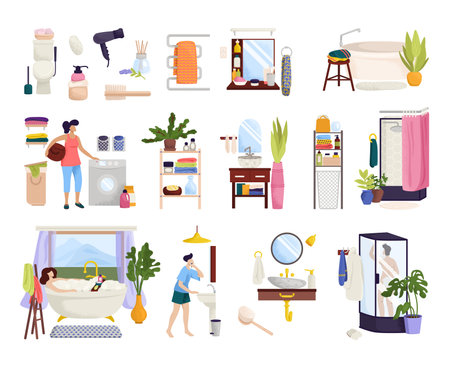Understanding Inclusive Bathroom Design
Inclusive bathroom design sits at the heart of contemporary British home renovations, championing the idea that everyone—regardless of age or ability—deserves comfort, safety, and independence in their daily routines. Rooted in the principles of universal design, inclusivity goes beyond mere compliance with accessibility standards; it is about cultivating spaces that anticipate and embrace the diverse needs of all individuals. This approach recognises the evolving demographic landscape in the UK, where multi-generational households are becoming increasingly common and where a focus on ageing-in-place is ever more relevant. By weaving inclusivity into the fabric of bathroom renovations, homeowners create environments that are not only functional but also welcoming and dignified for everyone. From thoughtful spatial layouts to intuitive fixtures and fittings, the significance of inclusive design lies in its ability to remove barriers, foster autonomy, and ultimately enhance quality of life across generations. As we explore this topic further, it becomes clear that truly accessible bathrooms are not just about ramps and grab rails—they reflect a broader cultural shift towards empathy, adaptability, and respect within British homes.
Legal Framework and UK Standards for Accessibility
Undertaking inclusive bathroom renovations in the UK requires a thorough understanding of the country’s legal framework and relevant building standards. Two key pieces of legislation underpin accessibility requirements: the Equality Act 2010 and Part M of the Building Regulations. These set out clear expectations for creating spaces that are accessible to individuals regardless of age, mobility, or ability.
The Equality Act 2010
The Equality Act makes it unlawful to discriminate against people on the grounds of disability in relation to access to goods, services, and facilities. In practical terms, this means that homeowners, landlords, and commercial property owners must consider reasonable adjustments during bathroom renovations to remove barriers faced by disabled users. The act encourages proactive design choices that support independence and dignity for all users, not just compliance for those with obvious needs.
Part M of the Building Regulations
Part M sets out the minimum standards required for accessibility in new builds and major refurbishments. It specifically addresses features like door widths, turning circles, fixture heights, and the provision of grab rails. These guidelines ensure bathrooms can be safely used by wheelchair users or those with limited mobility. While mandatory for public buildings and new homes, following Part M’s best practice recommendations is increasingly seen as good sense in private residential settings too—future-proofing homes for changing needs.
Key Requirements Comparison Table
| Requirement | Equality Act 2010 | Part M Building Regulations |
|---|---|---|
| Scope | Applies to all service providers and employers | Mandatory for new builds & significant refurbishments |
| Reasonable Adjustments | Yes (case-by-case basis) | No (prescriptive technical standards) |
| Specific Bathroom Provisions | General duty to provide access | Detailed guidance on layout & fittings |
Cultural Considerations in UK Homes
The British approach places strong emphasis on respecting privacy and comfort while upholding inclusivity. Renovators are encouraged not just to comply with regulations but also to reflect broader social values of equality and independence. Whether installing level-access showers or easy-to-use lever taps, these adaptations should blend seamlessly into traditional or contemporary British home aesthetics—ensuring dignity without drawing unnecessary attention to accessible features.

3. Practical Features for All-Age and Disability-Friendly Bathrooms
Designing an inclusive bathroom in the UK goes beyond aesthetics—it’s about creating a safe, comfortable, and accessible space for everyone, regardless of age or physical ability. Thoughtful adaptations not only enhance independence but also future-proof your home for changing needs. Below, we break down the most essential features to consider when planning an all-age and disability-friendly bathroom renovation.
Level-Access Showers: Barrier-Free Bathing
A level-access shower is a cornerstone of accessible bathroom design. Unlike traditional showers with raised trays, these are installed flush with the floor, eliminating trip hazards and making entry effortless for wheelchair users or anyone with limited mobility. Wet room designs are particularly popular across the UK as they combine style with practicality, allowing water to drain away seamlessly while keeping the space open and easy to navigate.
Grab Rails: Discreet Support Where Needed
Strategically placed grab rails provide vital support for those who need assistance with balance or stability. Modern grab rails come in a range of finishes and styles to blend discreetly into any décor, from classic chrome to contemporary matte black. Position them near toilets, showers, and baths—anywhere extra support might be required. These fittings make bathrooms safer without sacrificing style or comfort.
Non-Slip Flooring: Safety First
The right flooring can significantly reduce the risk of slips and falls—a particular concern in wet environments like bathrooms. Non-slip vinyl or textured porcelain tiles are both practical and stylish choices that meet British safety standards. It’s wise to choose flooring that offers both grip underfoot and easy cleaning, ensuring long-term durability as well as peace of mind for every member of the household.
Accessible Sinks and Toilets: Thoughtful Ergonomics
Sinks should be mounted at a height suitable for wheelchair access, with enough clearance underneath for knees. Consider lever taps or sensor-activated faucets that are easy to operate with limited dexterity. Raised-height toilets (sometimes called ‘comfort height’ in the UK) can make sitting down and standing up much easier for older adults or those with mobility issues. Where appropriate, opt for back-to-wall pans and wall-hung models to maximise floor space while providing additional accessibility.
Tailoring Features to Diverse Needs
No two households are alike, so the best inclusive bathrooms are tailored to their users’ unique requirements. Whether you’re accommodating a growing family, elderly relatives, or guests with disabilities, taking time to consult with occupational therapists or specialist bathroom designers can ensure your renovation meets everyone’s needs—now and in years to come.
4. Stylish and Subtle Adaptations
Modern British bathroom renovations are increasingly embracing the philosophy that accessibility does not have to come at the cost of aesthetics. Today’s inclusive designs blend seamlessly with contemporary style, ensuring that bathrooms remain inviting spaces for all users—regardless of age or ability. Rather than clinical or institutional looks, on-trend British interiors focus on a harmonious balance between function and fashion.
On-Trend Materials and Finishes
The material palette in accessible bathrooms has evolved, now featuring tactile surfaces that are both practical and visually appealing. Think slip-resistant porcelain tiles with a natural stone finish, or matte brassware that offers warmth and grip without sacrificing elegance. Waterproof laminate wall panels, which replicate the look of heritage wood panelling or metropolitan concrete, provide durability while echoing timeless British design cues.
| Feature | Inclusive Function | On-Trend Style |
|---|---|---|
| Slip-Resistant Flooring | Prevents slips for all ages | Stone-effect porcelain in muted tones |
| Wall-Mounted Basins | Wheelchair accessible, easier cleaning | Slimline, minimalist shapes with chrome fittings |
| Concealed Grab Rails | Discreet support where needed | Brushed brass or matt black finishes blending into décor |
| Thermostatic Showers | Scald prevention, easy temperature control | Sleek digital panels with tactile buttons |
Colour Schemes: Calm Meets Character
Bespoke colour palettes are central to British bathroom style. Soft greys, gentle blues, and earthy greens foster a sense of calm, while bold accents—such as navy feature walls or patterned encaustic tiles—add personality without overwhelming the senses. This approach ensures bathrooms feel safe, comforting and stylish for everyone.
Fixtures That Blend Form and Function
The latest fixtures are designed to be both beautiful and user-friendly. Lever taps offer arthritic hands greater comfort, while walk-in showers with low-profile trays cater to mobility needs yet appear effortlessly modern. Folding shower seats in oak or walnut finishes add a touch of luxury whilst remaining practical.
The British Touch: Blending Heritage and Modernity
Inclusive bathroom design in the UK is characterised by its respect for heritage details—such as metro tiles or cast iron towel radiators—alongside state-of-the-art adaptations. The result is an environment where everyone feels at home: dignified, independent, and utterly stylish.
5. Maximising Space in British Homes
Traditional British bathrooms are often compact, reflecting the architectural heritage of many homes across the UK. When undertaking inclusive bathroom renovations, it’s essential to address these spatial limitations while ensuring accessibility for people of all ages and abilities. Clever design strategies can transform even the smallest bathrooms into functional, comfortable spaces.
Embracing Space-Saving Layouts
To maximise space, opt for a layout that prioritises ease of movement. Consider replacing a traditional bath with a walk-in shower or wet room, which not only saves space but also provides level access for wheelchair users and those with limited mobility. Wall-hung basins and toilets free up valuable floor space, making the room feel larger and more open.
Bespoke Fittings for Unique Spaces
British homes often feature irregularly shaped rooms or quirky alcoves. Bespoke fittings can be tailored to fit awkward corners or unusual layouts, ensuring that every inch is put to good use. Custom-built shelving, recessed storage, and fold-down seating contribute to a clutter-free environment while maintaining accessibility.
Sliding Doors and Pocket Solutions
Traditional swinging doors can be cumbersome in tight spaces. Sliding doors or pocket doors are excellent alternatives, providing wider openings and easier access without encroaching on precious floor area. This small change can make a significant difference in usability, especially for those using mobility aids.
Smart Fixtures and Multi-Functional Design
Integrating smart fixtures such as sensor taps, adjustable-height showers, and illuminated mirrors enhances both safety and convenience. Multi-functional furniture—such as combined shower seats and grab rails—offers support without compromising on style or space. Thoughtful planning ensures that an inclusive bathroom in a British home is both practical and welcoming for everyone.
6. Finding Accredited Tradespeople and Funding Options
Securing the right professionals for your inclusive bathroom renovation is crucial to ensure safety, compliance, and quality. In the UK, it’s wise to seek out tradespeople who are not only experienced in accessible design but also hold relevant accreditations. Organisations such as TrustMark, the government-endorsed quality scheme, and the Federation of Master Builders (FMB) provide directories of vetted professionals committed to high standards. For specialist adaptations, consider those approved by Care & Repair England or registered with the Disabled Living Foundation (DLF).
How to Vet Your Chosen Professionals
Before committing, request references from previous clients with similar needs, verify public liability insurance, and confirm experience with Part M of Building Regulations—these outline legal requirements for accessible structures. Many councils recommend working with Certified Installers who have completed disability awareness training or hold CITB-recognised qualifications in adaptations for accessibility.
Exploring Grants and Financial Support
Bathroom adaptations can be an investment, but several funding options exist across the UK. The most notable is the Disabled Facilities Grant (DFG), available through your local council. This means-tested grant can help cover costs for essential changes like accessible showers, grab rails, or wider doorways. Applicants must have a permanent disability and intend to remain at their property for at least five years. Scotland and Wales offer similar grants via local authorities and Care & Repair Cymru. Additionally, some charities—including Age UK, Turn2us, and The Royal British Legion—may provide grants or low-interest loans depending on personal circumstances.
Your Step-by-Step Approach
- Assess your eligibility: Contact your local council or occupational therapist for an initial evaluation.
- Find accredited tradespeople: Use official directories and always check credentials.
- Apply for grants: Complete application forms thoroughly and gather all required evidence.
- Create a clear brief: Work closely with your chosen professional to develop a detailed plan reflecting your needs.
- Monitor progress: Stay involved throughout the process to ensure outcomes meet both accessibility standards and your personal requirements.
By leveraging trusted professionals and exploring available financial support, you can achieve a bathroom renovation that truly embodies inclusivity—ensuring dignity, independence, and comfort for everyone in your home.

